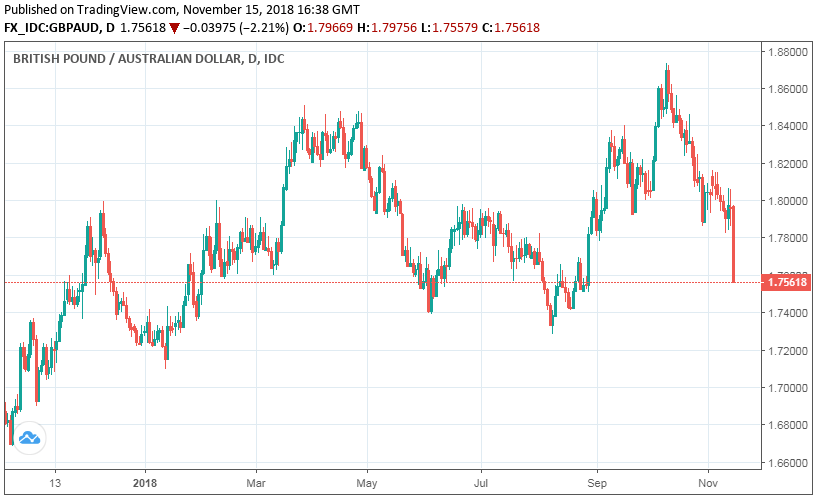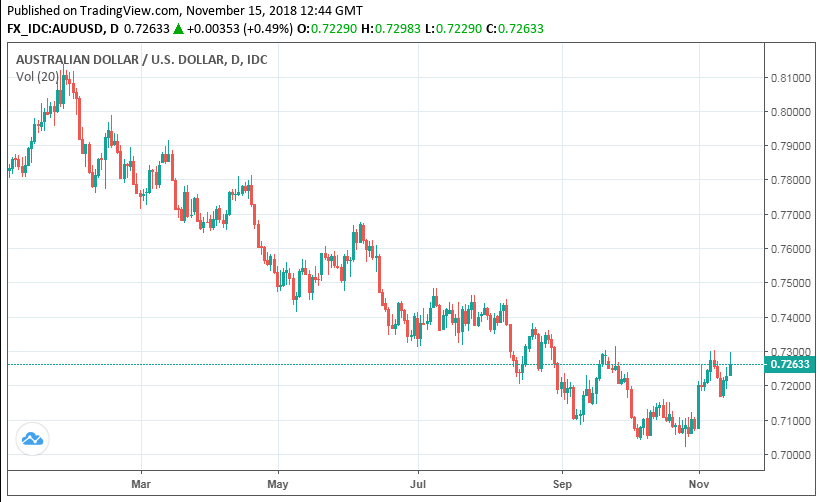Pound-to-Australian-Dollar Rate: Significant Upside Ahead following any Brexit Compromise says Westpac
- Written by: James Skinner
-

© Westpac
- GBP/AUD intraday loss tops 2% after Brexiteers rebel in London.
- GBP/AUD now close to what could form a short-term area of support.
- Upside from any Brexit "compromise" would reverse recent 6% decline.
The Pound-to-Australian-Dollar rate is close to bottoming out following this week's Brexit-induced plunge but any recovery will first require Brexiteering British politicians to abandon their rebellion, according to strategists at Westpac.
Upside could be substantial if Brexit-supporting lawmakers were to "compromise" by accepting Prime Minister Theresa May's proposed EU withdrawal agreement, as from that markets would receive a green light to price-in a May 2019 interest rate rise from the Bank of England (BoE).
"The coming weeks are vital for whether a workable Brexit agreement is reached so it is hard to have confidence in near term AUD performance versus the pound. Failure to compromise could see a return to GBP 0.57 or AUD 1.75 while positive Brexit news should see a reversal of the recent AUD gains, though perhaps not as far as the early Oct levels," says Sean Callow, a currency strategist at Westpac.
The Pound has fallen by more than 6% against the Australian Dollar since reaching a post-Brexit high of 1.8722 back in October. A reversal of this loss would require significant gains for the British currency.
Brexit Secretary Dominic Raab resigned from office Thursday in protest at Prime Minister Theresa May's Brexit proposals, triggering a wave of other departures and leading markets to fret that the risk of a "no deal Brexit" is rising rapidly.
The upshot for markets is that there's a rapidly growing risk of a vote of no confidence in the Prime Minister, and that the PM will not be able to garner enough support for her to eventually move the Withdrawal Bill through parliament.
Jacob Rees-Mogg, an influential backbench MP who leads a congregation of other Conservative Party Brexit-supporters, advised his fellow MPs on Thursday to submit letters of no confidence in Theresa May to the party chairman. 48 letters is enough to trigger a vote of confidence but 160 votes will be required to topple the Prime Minister.
This means the threat of a widely-deprecated "no deal Brexit" is rising because without the withdrawal agreement in place, the U.K. will depart the EU on March 29, 2019 and default to trading with it on World Trade Organization terms. Most analysts say this would be bad for the U.K. economy.

Above: Pound-to-Australian-Dollar rate shown at daily intervals.
The Pound-to-Aussie rate was quoted -2.13% lower at 1.7569 Thursday and has now risen just 1.8% for 2018 after declining -4.7% in the last month.
"We are entering highly uncertain times for domestic British politics and Brexit: the Pound hates uncertainty of this kind and the outlook for the currency is challenging," says Harry Wills, a dealer with Horizon Currency Ltd.
Wills is fielding questions on what the latest developments mean for those with international payments and can be contacted at
"GBP/AUD was around 1.95 before Brexit in June 2016 and has since marked out a much lower trading range," says Callow. "However, since mid-2017, GBP/AUD has more often followed the broad swings in market expectations for monetary policy at the RBA and BoE."

Above: AUD/USD rate shown at daily intervals.
Avoiding a so-called "No Deal Brexit" is important for the Pound because markets judge it to be an economically damaging pathway that will lead to slower growth and lower interest rates over the long-term.
The Bank of England raised its interest rate to 0.75% in August, citing its own inflation forecasts that suggest the consumer price index will remain consistently above the 2% target over coming years.
BoE officials have also been saying that rising household pay will stoke even further inflation pressures during the quarters ahead. They are current expected to lift rates around once each year until 2021, assuming a "smooth Brexit".
"AUD’s yield premium has trended lower since Sep 2017 when the BoE MPC struck a hawkish note, paving the way for the rate rise that was delivered in November 2017 (and again in August 2018). AUD’s yield advantage is very low in historical context and yield spreads suggest the recent AUD bounce may not be sustained," Callow says.
The Reserve Bank of Australia (RBA) has held its interest rate at a record low of 1.5% for more than two years now, citing below-target inflation and a litany of risks to the inflation and growth outlook.
RBA interest rate policy was a key instigator of the spectacular sell-off that drove the Australian Dollar almost 10% lower against its U.S. rival, and 6% lower against Sterling, during the 10 months to the beginning of November.
That policy and the global interest rate environment have reduced the incentive for investors to hold Aussie Dollars relative to Pounds and now provide an active incentive for individuals to dump Australian Dollars in favour of the U.S. greenback.
"Westpac Economics expects the RBA to be disappointed by the 2019 growth pace. As such, we remain comfortable with our forecast that the cash rate will remain on hold in 2019 and, indeed, in 2020," Callow says.
Changes in rates are only normally made in response to movements in inflation but impact currencies because of the push and pull influence they have on capital flows and their allure for short-term speculators.
Inflation has been below the 2% to 3% target for much of the time since 2014 and remains there more than two years after the RBA cut its interest rate to a record low to stimulate growth and stoke consumer price pressures.
The RBA says the main rate of inflation will rise by 2.25% in 2019, up from 1.9% currently, and that "underlying inflation", or true domestically generated inflation, will reach 2.25% at the end of next year. Neither of these numbers are high enough to improve the current Aussie interest rate outlook.
Advertisement
Bank-beating exchange rates. Get up to 5% more foreign exchange by using a specialist provider to get closer to the real market rate and avoid the gaping spreads charged by your bank when providing currency. Learn more here





